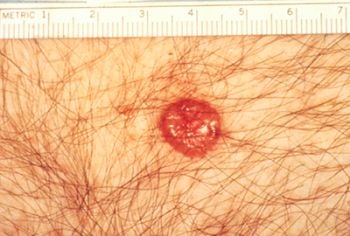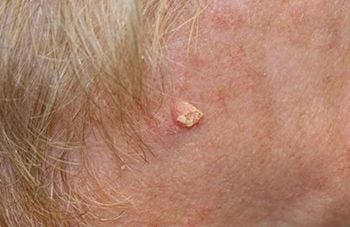Types of Skin Cancer
Knowing which type of skin cancer you have is important because it will affect your skin cancer treatment options. Skin cancers most often form on skin that has been exposed to the sun, including on your head, face, neck, hands, and arms. But skin cancer can occur anywhere, including areas that aren’t normally exposed to the sun.
There are three major types of skin cancers under two primary categories of skin cancer:
Nonmelanoma Skin Cancers
- Basal cell carcinoma (BCC)
- Squamous cell carcinoma (SCC)
Melanoma
Melanoma is the most dangerous type of skin cancer.
Non-Melanoma Skin Cancer Types
Basal cell cancer and squamous cell cancer are the two most common types of skin cancer. These cancers often form on the head, face, neck, hands, arms, and areas that are often exposed to the sun.
Basal Cell Carcinoma (BCC)
BCCs are abnormal, uncontrolled growths or lesions that arise in the skin’s basal cells, which line the lowest layer of the epidermis, called the basal cell layer. It usually occurs on areas of the skin that have been exposed to the sun and often look like open sores, red patches, shiny bumps, pink growths, or scars. It is most common on the face. Basal cell skin cancer grows slowly and rarely spreads to other parts of the body. If left untreated, however, it can grow into nearby areas and invade the bone or other tissues beneath the skin.
Squamous Cell Carcinoma (SCC)
Squamous cell skin cancer is an uncontrolled growth of abnormal cells that also occurs on parts of the skin that have been exposed to the sun – primarily the upper layers (epidermis). These areas typically include the rim of the ear, lower lip, face, balding scalp, neck, hands, arms, and legs. But it also may be in places on your body that do not receive any sun exposure, including inside the mouth and on the genitals. SCCs often look like scaly red patches, open sores, elevated growths with a central depression, or warts. These skin abnormalities may crust or bleed at times. Although not usually life-threatening, untreated squamous cell cancer can sometimes spread to lymph nodes and organs inside the body, causing serious complications.
If skin cancer spreads from its original place to another part of the body, the new growth has the same kind of abnormal cells and the same name as the primary growth, and it is still called skin cancer.
Melanoma Skin Cancer
While melanoma is much less common than basal cell and squamous cell skin cancers, it is the most serious type of cancer of the skin and has become more common every year because it is much more likely to spread if not caught early. In the United States, for example, the percentage of people who develop melanoma has more than doubled in the past 30 years. If recognized and treated early, however, melanoma is usually curable. If it is not caught early, this type of skin cancer can advance and spread to other parts of the body, where it becomes more difficult to treat.
Melanoma starts in cells in the skin called melanocytes, which are the cells found between the dermis and epidermis. They often look like moles, and some actually start out as moles.
These cancerous growths develop when UV radiation triggers genetic defects in skin cells that lead to the rapid multiplication of skin cells that form malignant (cancerous) tumors. Melanomas often resemble moles. Some even develop from moles. While the majority of melanomas are black or brown, some may be skin-colored, pink, red, purple, blue, or white.
Melanomas can develop anywhere on the skin, but they are more likely to develop on the trunk (chest and back) in men and on the legs in women. The neck and face are other common areas.
The most important warning sign of melanoma is a new spot on the skin or an existing spot that now appears abnormal.
Following the ABCDE guidelines can help you identify the usual signs of melanoma.
- Asymmetry - one half of a mole (or birthmark) does not match the other
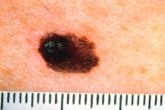
- Border - edges are irregular, ragged, notched, or blurred
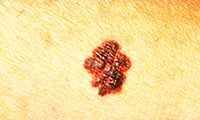
- Color - the color is uneven and may include different shades or brown or black, or sometimes with patches of pink, red, white, or blue
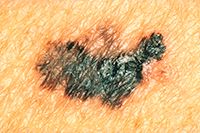
- Diameter - the spot is larger than 6 millimeters across (about the size of a pencil eraser)
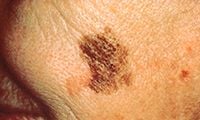
- Evolving - the mole is changing in size, shape, color, or elevation
Not all melanomas fit these rules. If you notice new spots on the skin or see changes in existing ones, tell your doctor or dermatologist. Click to view some photos that can help you identify whether a mole may be cancerous. These photos are meant as a guide, but it is always best to see a doctor who can give you an exam and perform a biopsy if needed.
Lesser Known Skin Cancers
While melanoma, basal cell carcinoma, and squamous cell carcinoma account for 99% of all skin cancer cases, the following are other forms of skin cancer that are also important to be aware of.
Merkel Cell Carcinoma (MCC)
A rare, aggressive skin cancer that primarily occurs on sun-exposed skin, such as the head and neck, as well as the arms, legs, and trunk. MCC usually appears as a firm, pink, red, or purple lump on the skin. Typically, these lumps are painless. Because MCC is fast-growing cancer, it can be hard to treat if it spreads to areas beyond the skin. Learn more about Merkel cell carcinoma from The American Cancer Society.
Kaposi Sarcoma (KS)
This type of cancer develops from the cells that line lymph or blood vessels. It can appear on the skin as a darkish/purple-colored tumor (or lesion) or on the inside of the mouth. Although lesions typically do not cause symptoms, they can spread to other parts of the body. KS is caused by the human herpesvirus-8 (HHV-8). Not everyone infected with HHV-8 will get KS. Typically, those most at risk are infected people whose immune systems have been weakened by disease or by drugs given after an organ transplant.
Types of Kaposi Sarcoma
There are a few different types of KS that are named after the populations that they are present; however, the changes within the KS cells are all very similar. The different types of KS include:
-
Epidemic (AIDS-related) Kaposi sarcoma
- Classic (Mediterranean) Kaposi sarcoma
- Endemic (African) Kaposi sarcoma
- Latrogenic (transplant-related) Kaposi sarcoma
- Kaposi sarcoma in HIV-negative men who have sex with men
Epidemic (AIDS-related) Kaposi sarcoma develops in those who are HIV infected. Human immunodeficiency virus (HIV) is the virus that causes AIDS. This type is the most common type of KS in the United States. Learn more about Kaposi sarcoma from The American Cancer Society.
Lymphoma of the Skin
Lymphoma is a cancer that starts in the lymphocytes--white blood cells that are vitally important in the functioning of the immune system. While lymphoma commonly involves the lymph nodes, it can begin in other lymphoid tissues, such as the spleen, bone marrow, and skin. The two main types of lymphomas are Hodgkin lymphoma and non-Hodgkin lymphoma. Lymphomas that originate only in the skin are called skin lymphoma (or cutaneous lymphoma).
In addition to some of the typical skin cancer treatments such as photodynamic therapies, chemotherapy, and targeted therapies, lymphoma of the skin may also be treated by stem cell transplants, immunotherapy treatments, and clinical trials involving lymphoma vaccines. Learn more about lymphoma of the skin from The American Cancer Society.


